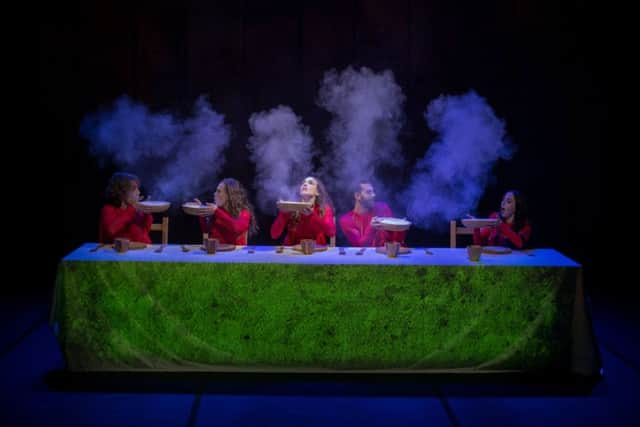Children are the audience of present not the future, says Cabrera


The table between us has already been set for tomorrow’s customers – only instead of glasses and cutlery, we’re surrounded by colouring pencils and drawing paper, waiting for small hands to bring them to life the following day.
A few hours earlier, his talented dancers were on stage performing the company’s latest production Vuelos, book-ended by creative activities for families in the café, and Cabrera couldn’t be happier. Having devoted the past two decades to choreographing work for children, he’s passionate about entertaining and educating young minds through the arts – and events such as this allow him to meet the audience he seeks to serve.
Advertisement
Hide AdAdvertisement
Hide Ad“It’s really nice for both me and the dancers,” he says, “because the children speak with us, give us their point of view about the show – and often have very funny things to say and clever questions to ask.”
Soon to arrive in Edinburgh as part of the International Festival, Vuelos (Flight in Spanish) is the latest in a long line of shows for young people created by Cabrera since he formed Aracaladanza in 1994. Born and raised in Argentina, it was the move to Madrid in 1989 that prompted him to start his own company.
“In Argentina, there were many good quality shows for children,” he explains. “But when I moved to Spain, I found that children’s shows were different, not of such high quality and I thought, ‘Oh my goodness’.
“It was sad for me to see, because it’s so important to give children good quality work. So I created my first show for young audiences 22 years ago – and all these years later, I’m still making shows for them, and am very happy to do so.”
Children’s theatre and dance the world over has improved dramatically in the past 20 years, with companies recognising there are many ways to hold a child’s attention without dumbing down.
For Cabrera, who works primarily with contemporary dance, the challenge is to capture, and recapture, children’s imaginations as his shows unfold – with Vuelos a perfect example of how he achieves his aim.
One minute the performers are wearing giant feathery wings, the next they’re interacting with moveable mirrors or digital images, galloping as horses or playing with cups and plates on a giant banqueting table. As soon as there is any risk of a wandering mind, new costumes or props arrive and the show changes gear.
Advertisement
Hide AdAdvertisement
Hide Ad“For me, the only difference between creating a show for adults and a show for children, is the rhythm,” says Cabrera. “It’s important to bring in different things. And if you mix the dance technique with surprises and other impressive things, it’s easier for children to watch the dance.”
Vuelos is full of unexpected surprises, all of which are inspired by the work and vision of one man – Leonardo da Vinci.
Although most famous for painting the Mona Lisa, the 15th century Italian packed a remarkable amount into his life and career. So much so, that Cabrera had to cherry pick which of da Vinci’s achievements, discoveries and interests to portray.
“I have so much respect for Leonardo da Vinci,” he says. “He was a painter, an architect, a sculptor, an anatomy scholar. If you look at all his work, he was an incredible man. And I think that for children to see that, is marvellous.
“But the work of Leonardo is so big, I had to concentrate on just one thing. So I decided that flight, and all the things he did relating to that, was the best way.”
Cabrera’s decision to focus on flight was based not only on da Vinci’s fascination with the subject (he drew several designs for “flying machines” in the late 1400s), but the way it relates to children and young people.
“As a child, we dream about being able to fly,” says Cabrera. “And then as a teenager, we start trying new things – we begin to make our own decisions and spread our wings.”
Advertisement
Hide AdAdvertisement
Hide AdVuelos isn’t the first time Cabrera has paid homage to an artist – the past three Aracaladanza shows have been inspired by Hieronymus Bosch, René Magritte and Joan Miró. Two of which, like Vuelos, benefitted from dynamic digital projections, which the dancers cleverly interact with.
“The videos are quite simple, but they’re very complicated for the dancers as they have to dance in time with them,” says Cabrera. “But technology is a good way to introduce the audience, both children and adults, to a dream world – to the magical world of the theatre.”
All of which takes time, and ten months before a single step is danced in the studio, Cabrera assembles his creative team. He puts forward a notion for the next production, encourages them to “put their artistic ideas into the pot”, and almost a year later, rehearsals begin.
Watching Vuelos, with its puppets, fun props, wonderfully bizarre costumes and sumptuous score, it’s clear that attention to detail is important to everyone.
“All the costumes are hand-painted,” explains Cabrera. “So when you see them from far away, under the lights, it’s fantastic.”
It’s just over a year since Aracaladanza’s last visit to Edinburgh, when Cabrera brought his Miró-inspired show, Constellations, to the Imaginate children’s festival. The company’s eagerness to return to the city will be echoed by all who saw it.
“We’re very happy to be coming back, for three reasons,” he says. “Firstly, the whole company loves Edinburgh. Secondly, I love the Edinburgh International Festival – I knew about it back when I lived in Argentina. And thirdly, it’s very important for there to be good shows for children in every festival in the world. Because children are not the audience of the future – they’re the audience of the present.”